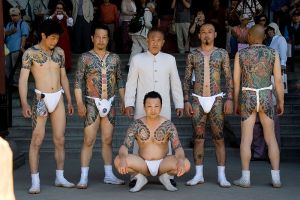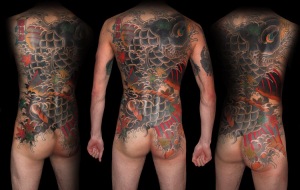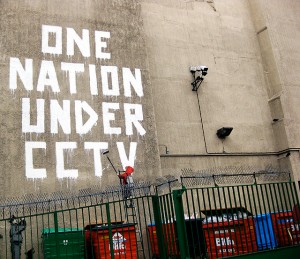When publishing changes, so does society. Investigate and compare the impact of two publication technologies, one pre-1900 and one post-2000, on a specific aspect of society (e.g. education, politics, creative industries, science, entertainment, social relationships).
The art of making something known has taken on various forms in the publishing industry and in turn, created catalysts for social change and social resistance. Visual art as a means of publication has privileged the power of imagery over printed words and has, in turn, created a gallery of aestheticised information that is capable of challenging the dominant, normative ideologies which are integral to the mainstream publishing industry. The publishing of art as social resistance has a long tradition inherent in the cultures of global minorities, such as the art of traditional Japanese Yakuza tattooing and the street art of the notorious artist Banksy. Both entities take imagery that is created in the mainstream or the cultures of the majority and subvert them in such a way that expresses their resistance to social imperialism and questions social issues pertaining to the dominant cultures. Consequently, the publication of these art forms invite and encourage dialogue on a local and a global level, thus creating foundations for further publishing opportunities.
Japanese Yakuza Tattooing:
During the 18th century Edo period in Japan the prevalence of punitive tattooing became a frequent form of punishment. Criminals were marked with bands around their arms, with the number of bands indicating the number of crimes they had committed. This form of punishment exposed their criminality to the public and exiled them from normative society, instead classing them as social outcasts. As a result, the increasing number of criminal outcasts led to the formation of gangs, which would come to be called Yakuza. An attempt was then made to cover up the ink, which the Japanese ruling class marked them with, resulting in a full-body tattoo suit adorned with elaborate traditional Japanese designs.
The Yakuza art of publishing self-affirmation for resistance:
The Yakuza tradition of tattooing is a form of self-publishing that attempts to make known the identity and status of the Yakuza member. Their reputation as outcasts to normative society is their catalyst for demonstrating subversion to those beliefs and projecting themselves in a way that attempts to overpower the normative social ideologies. It is their preoccupation with their presentation and their image that acts as the medium to communicate the message of their identity to society (Goodman, 1992).
Instead of paper or text, their canvas is their body and they use visual images to distribute their identities to the public, one that embodies a sense of power, solidarity and authorial status. The sight of one of these tattoos is enough to convey four important messages to the viewer:
- The Yakuza has passed an initiation rite to become a member of the order.
- Proof of the strength and perseverance of the Yakuza to endure the pain of receiving the tattoo
- The permanence of the tattoo signifies the irrevocable nature of their oath.
- The pride with which one bears the trademark of the Yakuza
The tattoo is a “symbolic costume” Goodman (1992) says, prohibited by common Confucius teachings and demonstrating a sign of impurity. The costume is created by the aggregation of various traditional Japanese symbols. These symbols include dragons, Koi fish and spiritual figures such as Fudō, and each have their own specific meaning, which they distribute through their pictorial emulation.
The Dragon is representative of strength, wisdom and bravery while the Koi fish, also associated with strength, further signifies stoicism. Finally, the spiritual figure Fudō, who is frequently associated with Buddhism stands as a guardian of morality and a force against those that commit injustice (Hendry, 2005). The aggregation of such visual data on the human canvas creates an archive of symbolism that is communicated to the public via the exposure of their skin. Furthermore, these archives are expressions of power; the more covered one’s body is in tattoos, the higher one’s sense of power becomes due to the extended amount of time spent enduring the pain of tattooing and a demonstration of the commitment to the Yakuza order.
The Yakuza’s adoption of traditional Japanese imagery reflects Baudrillard’s notion of simulation. Visual imagery is used in such a way that “masks and denatures a profound reality” (Baudrillard, 1981); that is to say that the once spiritual and mythical imagery associated with Japanese tradition was translated to the violent, resistive ideology of the Yakuza. Consequently, the new use of these images subverts their old ideological values and masks a new constructed reality. The Yakuza are thus demonstrating a form of resistance to the dominant values found in traditional images by re-appropriating them in a way that suits their sub-cultural dissent.
Furthermore we can attribute this form of simulation to the way in which the archive takes form on these human canvases. Baurdrillard asserts: “when the real is no longer what it was, nostalgia assumes its full meaning” (Baudrillard, 1981). Nostalgia, “the painful desire for a return to the authentic and singular origin” (Derrida, 1995), illustrates the Yakuza’s need for an archived publication of their ultimate identity and their strong affiliation with traditional Japanese values. By legitimizing their identity within history by archiving their identities, the Yakuza validate their resistance to the dominant ruling classes.
This is also done via the permanence of their visual archives; archives that do not become vulnerable to the eroding effects of overexposure. The Yakuza tattoo is very much one that demonstrates that, “much is preserved when little is written” (Innis as cited by Eisenstein, 1979) and further has the ability to transcend time due to its permanence. Their endurance has demonstrated that “the archivisation produces as much as it records” (Derrida, 1995), as tattoos remain an undesirable form of expression in Japan. Although their illegality was abolished after WWII, tattooing expresses an affiliation with the Yakuza and with resistance to the norm. It is a “self-inflicted stigma” (Goodman, 1992), a form of self-publication that negates Japan’s impartiality to non-conformity.
However, although unaccepted, the interaction of the artwork with the viewer creates a suspicion, and thus a dialogue. Communication thus denotes “the self [that] wants to say something to the other” (Goodman, 1992). The act of Yakuza tattooing publishes its resistance publically and calls for a response.
Banksy’s street art:
Banksy is a street artist originating from Bristol whose work has been particularly influential in the past 10 years. His means of publishing is street art; a subculture of graffiti art that encompasses lettering, sticker-bombing, stenciling and painting. Street art makes meaningful use of the city streets; an integral canvas pertaining to the central meaning of the artworks as the artworks work in accordance with the streets rather than publishing onto a passive blank canvas to be hung in a gallery. Banksy’s artistic interests do not lie within the celebrity accomplished through the institutionalization of his art, rather, in creating meaningful art that punctures the central public sphere, causing controversy and resistance. His subjects are overtly political, demonstrating rebellion and “[threatening] the status quo” (Witz as cited by Quintero, 2007).
The art of resistance:
Banksy’s art appears in the streets and on the sides of buildings. He states that, “the wall is just as good a place to publish as anywhere else” (Banksy as cited by Quintero, 2007) because the streets already contain their own contextual background, which he can integrate into the overall message of his artworks. Consequently, this “[creates] a dialogue” (Appel, 2006) between the images and the city that is unfettered by the limitative meanings of formalist artistic principals. Demonstrating this is the spontaneity of reception received by the viewer upon witnessing the artwork. The viewer enters the streetscape unaware of the potential of encountering Banksy’s street art, and thus, upon encounter, the viewer experiences “unsolicited aesthetic injection” (Riggle, 2010). This means that the viewer has no prior knowledge to the artist’s work, nor do they have an intention of viewing the artwork. In turn, the response is void of the dominant institutionalized contexts that shape meaning, and the viewer can thus create an authentic, individual perspective.
The absence of a designated art-space for Banksy’s work demonstrates a democratic form of distribution, which allows for the images to be consumed on a mass public level. By publishing art in a public environment that is not limited by the conducts of institutionalized spaces, Banksy raises the question of collective knowledge and freedom of information for the masses (Quintero, 2007).
Meta-communication is an imperative notion here. The data that Banksy communicates to the public demonstrates what Bateson and Reusch refers to as “communication about communication” (Bateson & Reusch, 1951). Banksy’s political imagery makes direct reference to global political issues that have been communicated to the masses. However, he does it in a way that creates transparency in the information or contests it. By creating a form of meta-communication, Banksy distributes possibilities that contest the current situation. For instance, his work on the West Bank Wall, which Israel built to separate them from Palestine, questions the political legitimacy of this act. Banksy paints windows on the wall that look out to an idyllic setting, as if showing what could be behind the wall. He paints children climbing ladders over the wall, and demonstrates the possibility of resistance. Banksy attempts to “turn the world’s most invasive and degrading structure into the world’s longest gallery of free speech” (Banksy as cited by Brasset, 2009). By creating a system of meta-communication, Banksy invites the public into discourse and into the possibility of publishing further data. By creating a space where varied perceptions meet, Banksy initiates the “establishment of a system of communication” (Bateson & Reusch, 1951).
Due to this system of meta-communication which Banksy creates via his artwork, he, in turn, creates a social body, which denotes the collection of bodies and events which communicate with one another by means of publishing (Grierson, 2009). Banksy’s street art is ephemeral; vulnerable to destruction due to its illegal nature. Because of this, street art converges with the Internet and overcomes illegality by entering a space that transcends its impermanence in both space and in time. His artworks become available to appropriation and interaction, with the construction of memes, interactive commentary on photographs of his artworks and the digitisation of his works into consumable products such as buttons and posters (Quintero 2007). Banksy’s artwork surpasses the illegality of its physical space by entering the online platform, and demonstrates that the convergence of our identities “in the computer and the street, is the sum of our distributed presence” (Turkle, as cited by Quintero, 2007).
Conclusion
The subversion of dominant ideological images through publication creates a system of communication by which resistance is made possible. Resistance is only possible if publications are made public; if they are realized in form that can be re-appropriated, remembered, stored and restored for future use. The traditional Japanese art of Yakuza tattooing and Banksy’s street are forms of publishing technologies, that, although are located in different centuries, use visual forms of publication in order to puncture dominant normative ideologies and ground themselves in the possibility of social debate and political influence.
References:
Appel, V, 2006, ‘Ghetto Art: Thousand Voices in the City’, Territoires, Issue 3, accessed 14 June 2013, <http://www.communicationandculture.co.uk/Ghetto%20Art.pdf>
Bateson, G & Ruesch, J, 1951, The Social Matrix of Psychiatry, First Edition, W.W. Norton & Company, Inc., New York, Digitised by the Internet Archive in 2011, accessed 17 June 2013, <http://archive.org/stream/communicationsoc00inrues/communicationsoc00inrues_djvu.txt>
Baudrillard, J, 1981, Simulation and Simulacra, accessed 17 June 2013 via Georgetown University, <https://www9.georgetown.edu/faculty/irvinem/theory/baudrillard-simulacra_and_simulation.pdf>
Brassett, J, 2009, ‘British irony, global justice: A pragmatic reading of Chris Brown, Banksy and Gervais’, Review of International Studies, Vol. 35, Issue 1, pp. 219-245, accessed 14 June 2013, <http://journals.cambridge.org/action/displayFulltext?type=1&fid=3291876&jid=RIS&volumeId=35&issueId=01&aid=3291872>
Cecchini, C, 2002, ‘Banksy: Urban Guerilla Art’, Industrial Design: Designing the Void, Issue 44, accessed 14 June 2013, <http://www.academia.edu/1474662/Banksy_urban_guerrilla_art>
Derrida, J & Prenowitz, E, 1995, ‘Archive Fever: A Freudian Impression’, Diacritics, Vol. 25, No. 2, pp. 9-63, accessed 17 June 2013, <http://www.jstor.org.wwwproxy0.library.unsw.edu.au/stable/pdfplus/465144.pdf?acceptTC=true>
Eisenstein, E, 1979, ‘Defining the Initial Shift: Some features of print culture’, The rinting Press as an Agent of Change, Vol. 1, Cambridge: Cambridge University Press, pp. 43-163, accessed 14 June via ARTS2090 Study Kit
Goodman R, 1992, Ideology and Practice in Modern Japan, e-book, accessed 15 June 2013, <http://books.google.com.au/books?id=V8nigZU44o4C&pg=PT5&dq=Ideology+and+Practice+in+Modern+Japan++edited+by+Roger+Goodman,+Kirsten+Refsing&hl=en&sa=X&ei=0wO_UdGCN4n0lAXFwID4DA&ved=0CDAQ6AEwAA>
Grierson, E, 2009, ‘Inscribing the Social Body: Economics of Image/Text in the Public Domain’, accessed 17 June 2013, <http://schoolofartgalleries.dsc.rmit.edu.au/PSSR/exhibitions/2009/body/inscribing-the-social.pdf>
Hendry, J, 2005, Japan at Play: The Ludic and the Logic of Power, e-book, accessed 15 June 2013, <http://books.google.com.au/books?id=ZKxos1J2kS0C&printsec=frontcover&source=gbs_ge_summary_r&cad=0#v=onepage&q&f=false>
Quintero, N, 2007, ‘The Screen on the Street: Convergence and Agonic Coincidences Between Graffiti and New Media Objects’, Artnodes E-Journal on Art, Science and Technology, December 2007, accessed 14 June 2013, <http://www.uoc.edu/artnodes/7/dt/eng/quintero.pdf>
Riggle, N, 2010, ‘Street Art: The Transfiguration of the Commonplaces’, The Journal of Aesthetics and Art Criticism, Vol. 68, Issue 3, pp. 243-257, accessed 14 June 2013, <http://onlinelibrary.wiley.com/doi/10.1111/j.1540-6245.2010.01416.x/abstract>




Reblogged this on Kultural Yakuza.
Brilliant. Very informative, much food for thought.